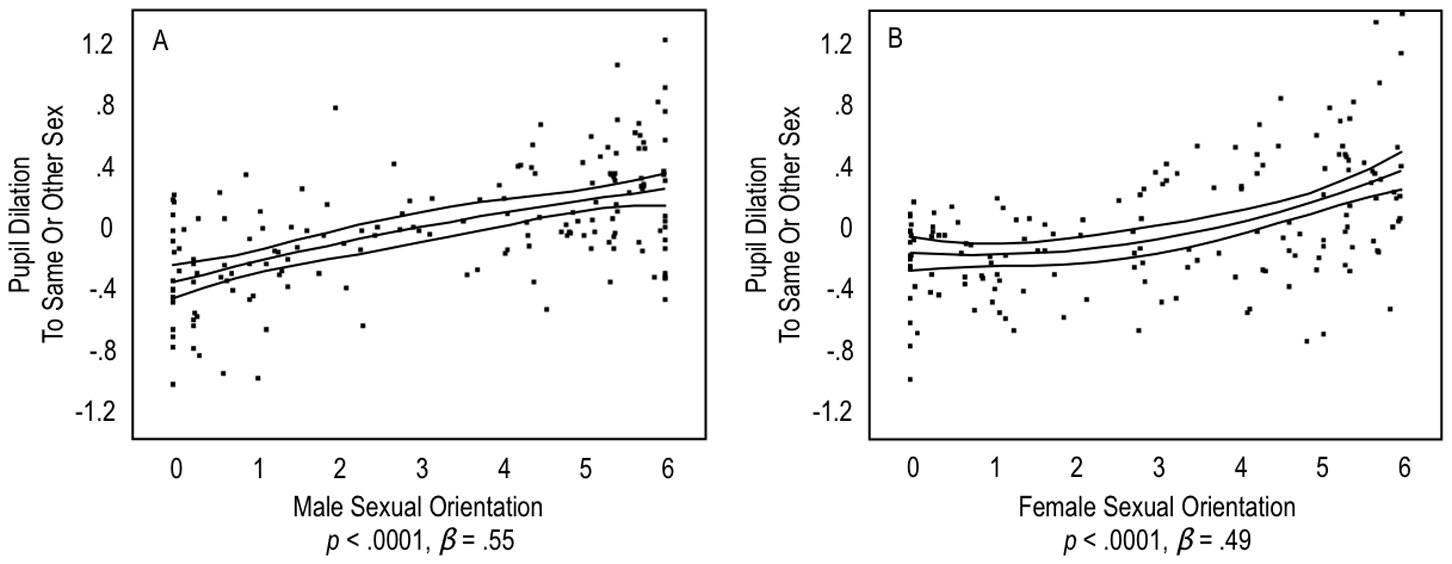Sexual orientation can be revealed by pupil dilation to attractive people, say researchers who used a specialized infrared lens to measure pupillary changes of participants watching erotic videos. Pupils were pretty accurate: they widened most to videos of people who participants found attractive, thereby revealing where they were on the sexual spectrum from heterosexual to homosexual.
Previous studies also tried to measure sexual orientation, but surveys are obviously useless and taking physiological measurements, like assessing genital arousal, have obvious problems. The authors say the new work adds considerably more to the field of sexuality research than a new measure. As expected, heterosexual men showed strong pupillary responses to sexual videos of women, and little to men; heterosexual women, however, showed pupillary responses to both sexes. This result confirms previous research suggesting that women have a very different type of sexuality than men.
The study weighs in on the debate of male bisexuality too. Some claims were that bisexual men do not base their sexual identity on their physiological sexual arousal but on romantic and identity issues. Contrary to this claim, bisexual men in the new study showed substantial pupil dilations to sexual videos of both men and women.

Pupil dilation to the same sex and the other sex. Panel A shows men’s responses and Panel B shows women’s’ responses. Y Axes reflect z-scores within participants: positive numbers indicate dilation to the same sex, and negative numbers indicate dilation to the other sex. X Axes reflect self-reported sexual orientation: 0 represents an exclusive heterosexual orientation, 3 an even bisexual orientation, and 6 an exclusive homosexual orientation. Triple lines represent regression coefficients with 95% confidence intervals. Dots represent participants’ average scores. β’s are standardized coefficients for linear effects. Credit: doi:10.1371/journal.pone.0040256.g001
"We wanted to find an alternative measure that would be an automatic indication of sexual orientation, but without being as invasive as previous measures. Pupillary responses are exactly that," says Gerulf Rieger, lead author of the new study and research fellow at Cornell. "With this new technology we are able to explore sexual orientation of people who would never participate in a study on genital arousal, such as people from traditional cultures. This will give us a much better understanding how sexuality is expressed across the planet."
"We can now finally argue that a flexible sexual desire is not simply restricted to women – some men have it, too, and it is reflected in their pupils," says Ritch C. Savin-Williams, co-author and professor in Human Development at Cornell. "In fact, not even a division into 'straight,' 'bi,' and 'gay' tells the full story. Men who identity as 'mostly straight' really exist both in their identity and their pupil response; they are more aroused to males than straight men, but much less so than both bisexual and gay men," Savin-Williams notes.
Like autism, sexuality may soon get a whole spectrum of labels that apply to the bulk of society.
Rieger G, Savin-Williams RC (2012) The Eyes Have It: Sex and Sexual Orientation Differences in Pupil Dilation Patterns. PLoS ONE 7(8):e40256. doi:10.1371/journal.pone.0040256





Comments